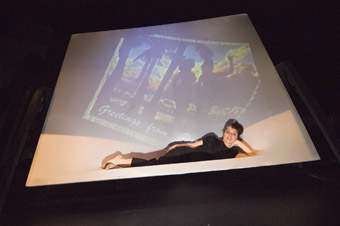 |
Linda Mancini, Bikini |
When I read this in the Ten Days on the Island program I assumed it was a joke—a fictional premise for an entertaining performance. The diabolical truth, that the bikini was actually named after the Bikini Atoll, was confirmed by a friend; and drastically changed my expectations for the production (also named) Bikini. Linda Mancini’s production is politically satirical, a one woman, multiple character show connecting Bikini and the bikini, and ridiculing the US army, an ignorant public and the fashion industry along the way.
We are first introduced to the embarrassed Chrissie, a 14-year-old girl trying to change her image in order to enter a bikini contest. “My mother always told me ‘you’re too fat to wear a bikini’”, she announces before taking us to visit the beauty salon to share the experience of her first horrific bikini wax. Another woman with a strong New Yorker accent, playing charades, guesses “the bombings of Bikini a-toll booth”…“What the hell is that Louis?” she yells angrily at her invisible partner, shockingly ignorant of the tragedy. Later in the performance, this woman's sister-in-law embraces a one-off opportunity to travel to the still radioactive ring of Islands, a caricature of the American public and their tendency to holiday almost anywhere.
Rita Marshall is Mancini’s third character transformation: a nationalistic ex-US army officer who served at Bikini Atoll during the bombings. She describes her pride in serving her country, and seems completely blind to the environmental devastation, the deaths following animal testing, the permanent relocation of the indigenous peoples of Bikini, as well as the permanent health effects on the army personnel who were involved. Her husband passed away at a young age, Rita explains, glossing over the fact that the death was related to nuclear exposure. Ironically, Rita adds that her own sight has been affected by cancer.
In a momentary dimming of lights, Mancini promptly changes into a fashion show presenter promoting “Fashion with a conscience.” She decides that ‘the network’ should hold a bikini competition on Bikini Atoll. “Is it safe? Can someone find that out for me?”
Mancini is swift in her character changes and has made each of her characters distinctive. Rita sits straight in her chair, eyes squinting and talking in a slow Texas drawl; Chrissie stands embarrassed twirling her top through her fingers, and has a juvenile style of speech; the fashion presenter stands prepared to dazzle, directing technical assistants to find better images which flash on the screen behind her; and the New Yorker talks loudly into a telephone, at her new beauty parlour Coco Ch’nails, complaining constantly about her sister-in-law.
Bikini is intriguing for its lack of props and simple design – one chair and a screen. The screen also doubles as a table, a door, a beach and finally a bed; and is stretched with an impressively hardy lycra-type fabric, which easily holds Mancini’s weight.
The serious truth behind the Bikini Atoll bombings is at times at odds with Mancini’s comedy. This was more than satire. When shown the photos of animal testing, tears ran down my face. I stopped following the story quite as intently.
Bikini was was clever in its interweaving of characters, often small but poignant observations, and its political satire - a very slick production that left me both enlightened but entertained. Mancini’s Bikini reminds us about a largely forgotten historical event, warning us not to repeat the same mistake.
Bikini, writer, performer Linda Mancini, set design Brad Stokes, video Carol Glaab; Peacock Theatre, March 29-April 1, Ten Days on the Island; Ten Days on the Island, March 29-31
Lucy Hawthorne is a Hobart based writer with a background in visual arts (sculpture, drawing, sound and installation art), music and dog obsession. She is a postgraduate studying art and design theory at the Tasmanian School of Art.
© Lucy Hawthorne; for permission to reproduce apply to [email protected]








 back
back